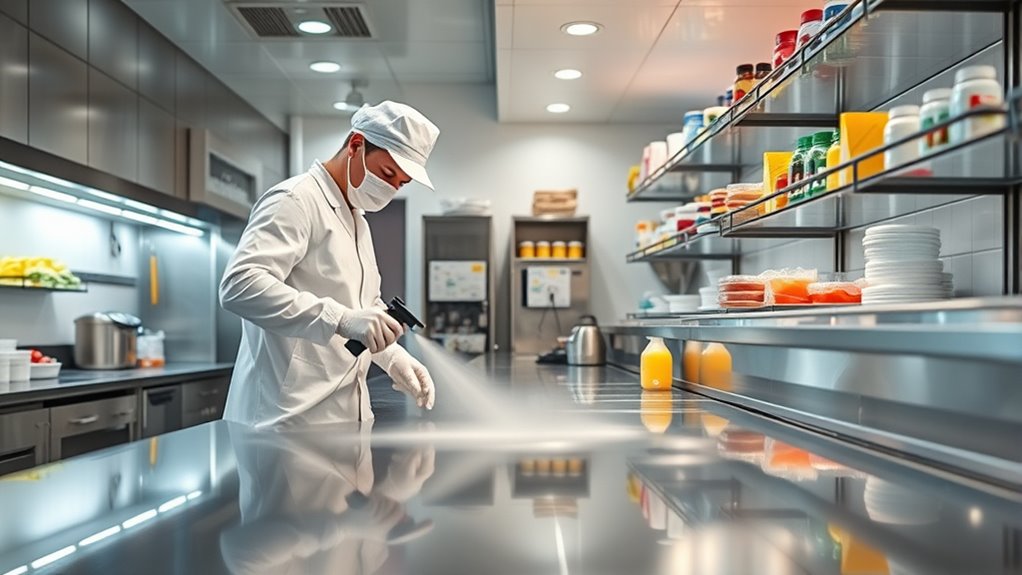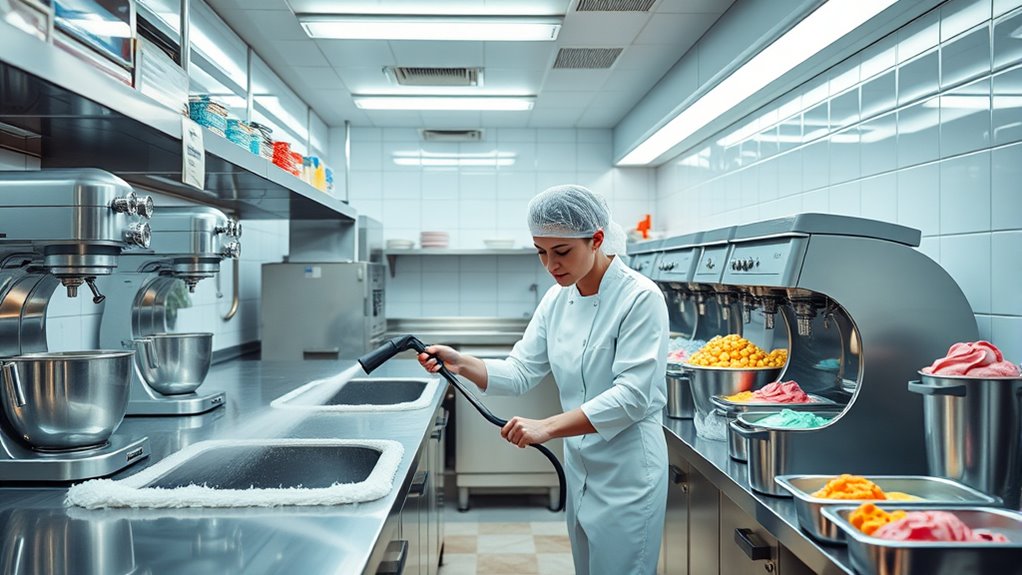During the midnight clean-down, you need to focus on thorough hygiene routines to keep your gelato kitchen safe. Store gelato in airtight containers at -20°C, label for rotation, and organize storage areas to prevent cross-contamination. Wash hands properly, disinfect surfaces and tools regularly, and monitor temperatures consistently. Maintaining these routines guarantees product quality and safety. If you want to master all the best practices, there’s more you should know.
Key Takeaways
- Implement regular cleaning and sanitization of surfaces, utensils, and storage areas to prevent bacterial growth and cross-contamination.
- Ensure gelato is stored at consistent, proper temperatures (-20°C) with regular monitoring to prevent spoilage.
- Enforce thorough handwashing protocols for staff before handling ingredients or after contamination risks.
- Label and rotate stock to use fresh gelato, avoiding the use of compromised or expired products.
- Conduct ongoing staff training and inspections to maintain high hygiene standards and ensure safety compliance.

Maintaining strict hygiene routines is essential to guarantee the safety and quality of gelato served in your kitchen. When it comes to gelato storage, proper practices help prevent contamination and spoilage. Always store gelato in airtight containers at the correct temperature, typically around -20°C, to preserve freshness and prevent bacterial growth. Label each container with the date it was made or opened, so you can rotate stock efficiently and avoid using old or compromised gelato. Keep storage areas clean and organized, ensuring that raw ingredients, tools, and finished products are separated to prevent cross-contamination. Regularly check your gelato storage units for leaks or temperature fluctuations, as these can compromise the safety of your product.
Equally important is maintaining good employee handwashing habits. You should establish a strict hand hygiene protocol, requiring all staff to wash their hands thoroughly with soap and hot water before handling ingredients, after using the restroom, and after any activity that could introduce contaminants. Handwashing isn’t just a quick rinse—it needs to be thorough, covering all surfaces of the hands and fingernails for at least 20 seconds. Provide accessible handwashing stations equipped with soap, clean towels, or hand dryers, ensuring your team can comply easily. Consider implementing hand sanitizer stations as an additional step, but remember that sanitizer isn’t a substitute for proper handwashing, especially when handling food.
In your daily cleaning routines, emphasize the importance of sanitizing all surfaces, utensils, and equipment that come into contact with gelato. Regularly disinfect worktables, scoops, spatulas, and storage containers to eliminate any lingering bacteria or mold. Train your staff to recognize the signs of contamination and to follow proper hygiene protocols consistently. Reinforce that hygiene isn’t a one-time task but an ongoing commitment, especially during high-volume periods or when handling multiple flavors. Additionally, understanding the importance of contrast ratio and other image quality factors can help ensure that visual presentation in your shop meets high standards and attracts customers.
Frequently Asked Questions
How Often Should Gelato Equipment Be Disinfected?
You should disinfect gelato equipment daily to guarantee safety and quality. Follow your sanitization schedules strictly, especially after each use or batch. Regular equipment maintenance helps prevent contamination and keeps everything running smoothly. Don’t overlook thorough cleaning of all surfaces, utensils, and storage areas. By adhering to consistent disinfection routines, you protect your customers and maintain high hygiene standards, keeping your gelato kitchen safe and compliant with health regulations.
What Are the Best Cleaning Products for Gelato Kitchens?
When choosing cleaning products for your gelato kitchen, prioritize those that support effective sanitation techniques and align with your cleaning schedules. Use food-safe, non-abrasive disinfectants that eliminate bacteria without damaging equipment. Regularly updating your products guarantees consistent cleanliness. Remember, the right cleaning products help maintain a safe environment, preserve the quality of your gelato, and meet health standards. Always follow manufacturer instructions for ideal results.
How to Prevent Cross-Contamination During Cleaning?
Imagine avoiding cross-contamination in your gelato kitchen, even during busy times. You can do this by strictly following proper ingredient handling protocols and ensuring staff hygiene. Always use separate tools and cleaning equipment for different ingredients, and train your team to wash hands thoroughly before and after handling each product. This proactive approach keeps your workspace safe, maintains product quality, and protects your customers from potential health risks.
Are There Specific Hygiene Certifications for Gelato Kitchens?
You might wonder if there are specific hygiene certifications for gelato kitchens. While no universal certification is exclusive to gelato, certification standards like ServSafe, HACCP, and local health department licenses guarantee hygiene compliance. These programs help you maintain proper sanitation, prevent contamination, and meet safety regulations. Achieving such certifications demonstrates your commitment to hygiene standards, ensuring your gelato kitchen stays safe and compliant with industry best practices.
What PPE Is Recommended During Cleaning Routines?
During cleaning routines, you should always wear appropriate personal protective equipment (PPE) to guarantee safety and hygiene. This includes gloves to protect your skin, aprons to keep clothing clean, and masks or face shields if you’re handling strong cleaning agents or aerosols. Following proper cleaning protocols, PPE helps prevent cross-contamination and keeps you safe, maintaining a hygienic environment in your gelato kitchen.
Conclusion
Maintaining strict hygiene routines is crucial to keeping your gelato kitchen safe. Did you know that improper cleaning can lead to contamination risks increasing by up to 70%? By implementing a thorough midnight clean-down, you ensure your workspace stays spotless and your products stay safe for customers. Consistent routines protect your reputation and prevent health issues. Stay diligent, follow best practices, and remember—cleanliness isn’t just a task, it’s your best defense.









